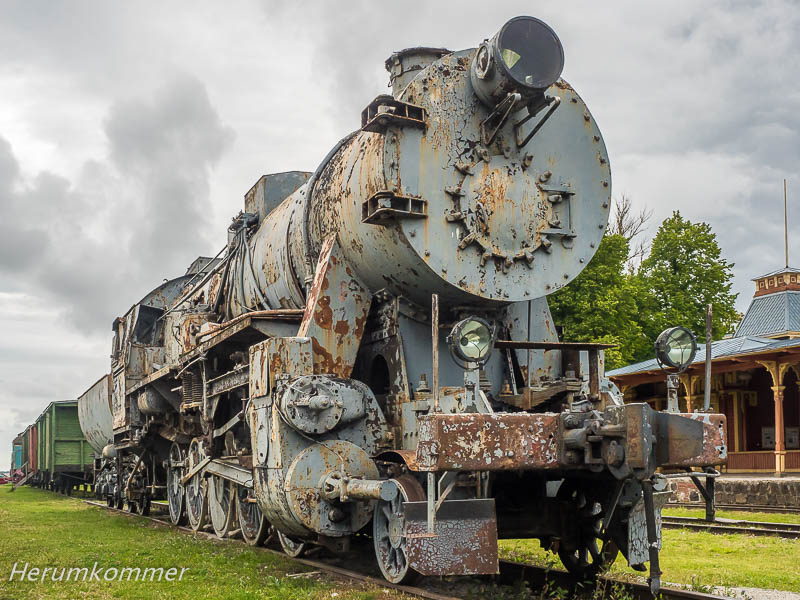
Nicht überall auf der Welt sind Eisenbahnen moderne Verkehrsmittel. Ältere Fahrzeuge, zumal gut erhaltene, sind Hingucker. Aber auch weniger gut erhaltene können eine morbide Nostalgie ausstrahlen.
Auf unseren Reisen haben wir interessante Exemplare in Estland, Deutschland, Polen, Rumänien, den Niederlanden, Chile, Uruguay, den USA und Kanada gesehen bzw. erlebt.
- Einen sehr gut restaurierter historischer Bahnhof aus der Zarenzeit mit sehr verschiedenartigen alten Lokomotiven und anderen Fahrzeugen haben wir in Estland entdeckt.
- Für die Bewohner von ein paar der Halligen im Schleswig-Holsteinischen Wattenmeer dienen so genannte Lorenbahnen als Verkehrsmittel zum Festland und zurück.
- Auf dem Kanał Elbląski (Elbląg-Kanal) im Norden von Polen fahren selbstverständlich Schiffe. Aber die fahren zur Überwindung des Höhenunterschieds von insgesamt etwa 100 m auf einigen Passagen auf Schienen.
- Die letzte dampfbetriebene Waldbahn Europas fährt im Norden von Rumänien. Auf ihrem Endbahnhof in Vişeu de Sus konnten wir eine große Anzahl historischer und variantenreich skurriler Fahrzeuge nicht nur sehen sondern auch in sie einsteigen.
- Am Ijsselmeer in den Niederlanden, zwischen Hoorn und Medemblik, pendelt eine Museums-Dampfstraßenbahn (Museumstoomtram). Sie ist besonders liebevoll gepflegt.
- In der Atacama-Wüste im Norden von Chile wird in vielen Minen Bergbau betrieben. Für Transporte gab es früher Eisenbahnen, die offensichtlich nicht mehr benötigt werden. Ihre Überreste sind in spektakulärer Weise der Erosion überlassen.
- Im südlichen Südamerika haben wir sehr viele rostige, zugewucherte oder unterspülte Eisenbahnschienen gesehen, die also eindeutig außer Betrieb waren. Am Bahnhof von Queguay, im Westen von Uruguay, fahren tatsächlich Züge über die recht neuen Gleise. Sehr alte Waggons auf Abstellgleisen sind hier die Attraktion.
- Eine der am besten erhaltenen Dampfeisenbahnen des frühen 20. Jahrhunderts ist die Nevada Northern Railway in den USA. Zur Aufrechterhaltung ihres Betriebs dienen Maschinenwerkstatt und Lokschuppen am Bahnhof East Ely.
- Einige sehr exotische Fahrzeuge haben wir in Kanada im New Brunswick Railway Museum in Hillsborough gesehen.
Historic railways
Railways are not a modern means of transport everywhere in the world. Older vehicles, especially those in good condition, are eye-catching. But even less well-preserved ones can exude a morbid nostalgia.
On our travels we have seen and experienced interesting specimens in Estonia, Germany, Poland, Romania, the Netherlands, Chile, Uruguay, the USA and Canada.
- We discovered a very well restored historic railway station from the Tsarist era with a wide variety of old locomotives and other vehicles in Estonia.
- For the inhabitants of some of the Hallig islands in the Schleswig-Holstein Wadden Sea, so-called tugger trains serve as a means of transport to and from the mainland.
- Of course, ships travel on the Kanał Elbląski (Elbląg Canal) in the north of Poland. But they travel on rails on some passages to overcome the height difference of around 100 metres in total.
- The last steam-powered forest railway in Europe runs in the north of Romania. At its terminus in Vişeu de Sus, we were not only able to see a large number of historic and variedly quirky vehicles, but also board them.
- At the Ijsselmeer in the Netherlands, between Hoorn and Medemblik, a Museum Steam Tram (Museumstoomtram) commutes. It is particularly well maintained.
- Mining is carried out in many mines in the Atacama Desert in the north of Chile. There used to be railways for transport, which are obviously no longer needed. Their remains have been spectacularly left to erosion.
- In southern South America, we saw a lot of rusty, overgrown or washed out railway tracks that were clearly out of service. At Queguay railway station in western Uruguay, trains actually run over the fairly new tracks. Very old wagons on sidings are the attraction here.
- One of the best-preserved steam railways of the early 20th century is the Nevada Northern Railway in the USA. The engine workshop and engine shed at East Ely station serve to maintain its operation.
- We saw some very exotic vehicles in Canada at the New Brunswick Railway Museum at Hillsborough.
